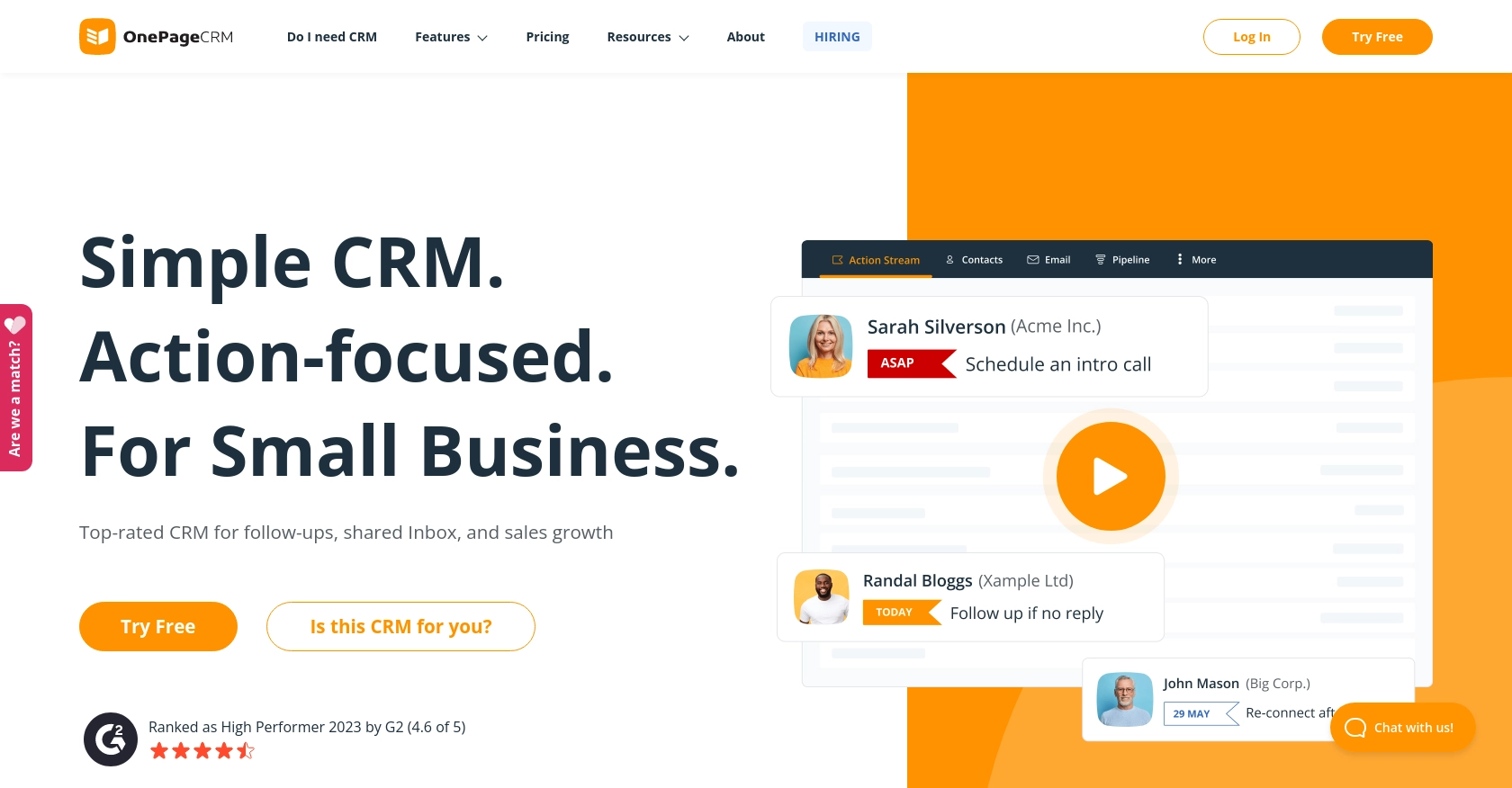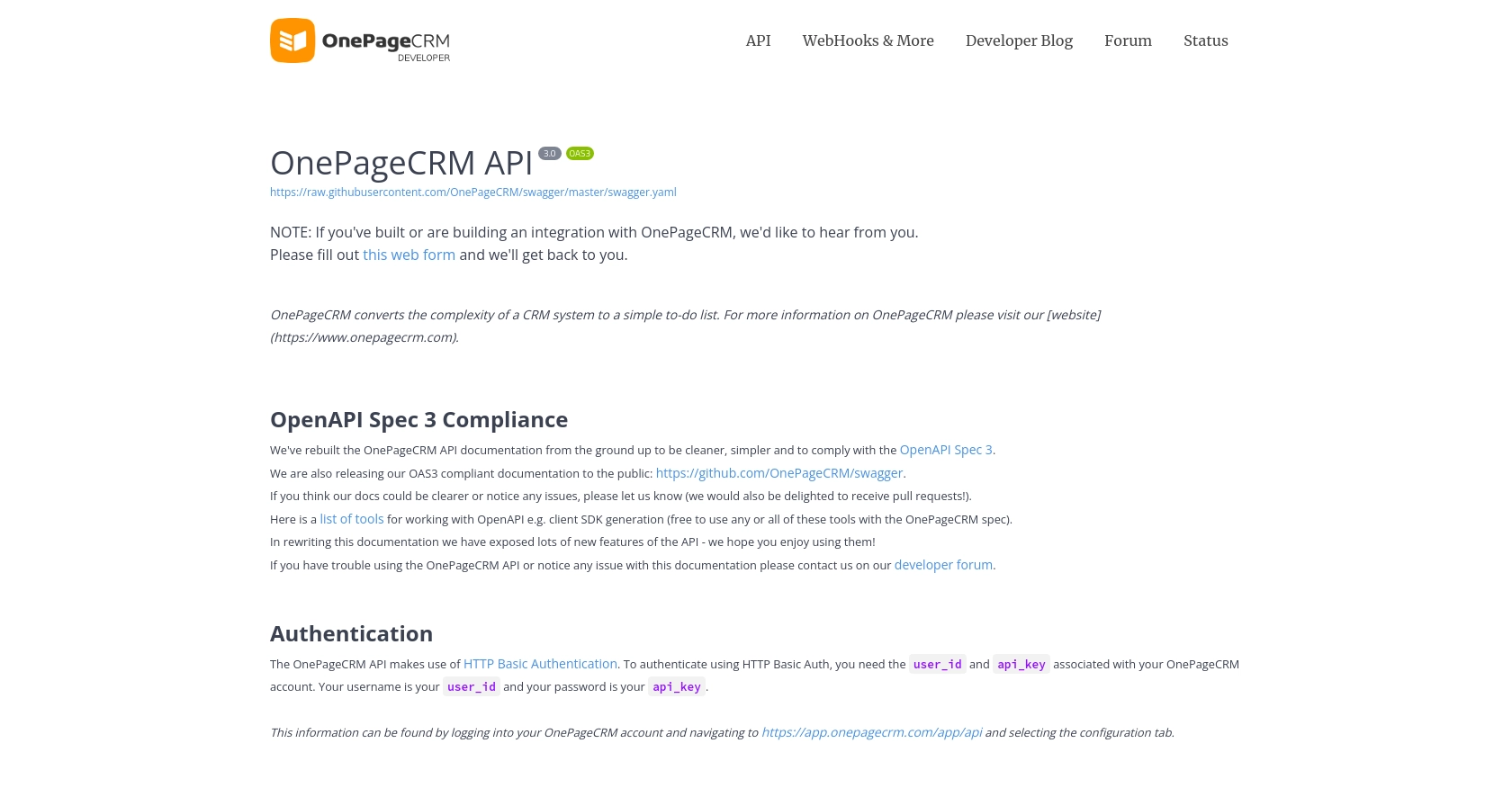Using the OnePageCRM API to Get Contacts (with Python examples)

Introduction to OnePageCRM API Integration
OnePageCRM is a dynamic customer relationship management tool designed to simplify sales processes for businesses. It offers a streamlined approach to managing contacts, deals, and tasks, making it an invaluable resource for sales teams aiming to enhance productivity and efficiency.
Integrating with the OnePageCRM API allows developers to access and manage contact data programmatically, enabling seamless integration with other business tools and systems. For example, a developer might use the OnePageCRM API to retrieve contact information and synchronize it with an external marketing platform, ensuring that sales and marketing teams have consistent and up-to-date data.
Setting Up Your OnePageCRM Test Account for API Integration
Before diving into the OnePageCRM API, it's essential to set up a test account to experiment with API calls without affecting live data. OnePageCRM offers a straightforward process to get started with their API, ensuring developers can efficiently test and integrate their applications.
Creating a OnePageCRM Sandbox Account
To begin, you'll need to create a OnePageCRM account. Follow these steps to set up your sandbox environment:
- Visit the OnePageCRM website and sign up for a free trial account.
- Complete the registration process by providing the necessary details, such as your name, email, and company information.
- Once registered, log in to your OnePageCRM account to access the dashboard.
Generating API Credentials for OnePageCRM
OnePageCRM uses a custom authentication method for API access. Follow these steps to generate the necessary credentials:
- Navigate to the Settings section in your OnePageCRM dashboard.
- Under the API & Integrations tab, locate the option to create a new API key.
- Click on Create API Key and fill in the required information, such as the application name and description.
- Once created, you will receive an API key. Make sure to store this key securely, as it will be used to authenticate your API requests.
Configuring OAuth for OnePageCRM API Access
For enhanced security, OnePageCRM supports OAuth-based authentication. Here's how to set it up:
- In the API & Integrations section, select Create OAuth App.
- Provide the necessary details, including the redirect URI and scopes required for your application.
- After creating the OAuth app, you will receive a Client ID and Client Secret. These credentials are crucial for obtaining access tokens.
With your sandbox account and API credentials ready, you're all set to start making API calls to OnePageCRM. In the next section, we'll explore how to use Python to interact with the OnePageCRM API and retrieve contact data.

sbb-itb-96038d7
Making API Calls to Retrieve Contacts from OnePageCRM Using Python
With your OnePageCRM sandbox account and API credentials set up, you can now proceed to make API calls to retrieve contact data. This section will guide you through the process of using Python to interact with the OnePageCRM API.
Setting Up Your Python Environment for OnePageCRM API Integration
Before making API calls, ensure you have the necessary tools and libraries installed. This tutorial uses Python, so make sure you have Python 3.x installed on your machine. Additionally, you'll need the requests library to handle HTTP requests.
pip install requestsWriting Python Code to Fetch Contacts from OnePageCRM
Now that your environment is ready, you can write a Python script to fetch contacts from OnePageCRM. Create a file named get_onepagecrm_contacts.py and add the following code:
import requests
# Set the API endpoint and headers
base_url = "https://app.onepagecrm.com/api/v3/"
endpoint = "contacts"
url = f"{base_url}{endpoint}"
headers = {
"Authorization": "Bearer YOUR_API_KEY"
}
# Make a GET request to the API
response = requests.get(url, headers=headers)
# Check if the request was successful
if response.status_code == 200:
contacts = response.json()
for contact in contacts:
print(contact)
else:
print(f"Failed to retrieve contacts: {response.status_code} - {response.text}")
Replace YOUR_API_KEY with the API key you generated earlier. This script sets up the API endpoint and headers, makes a GET request to retrieve contacts, and prints the contact data if the request is successful.
Running Your Python Script to Access OnePageCRM Contacts
To execute the script, run the following command in your terminal:
python get_onepagecrm_contacts.pyIf successful, you should see a list of contacts printed in your terminal. This confirms that your API call to OnePageCRM was successful.
Handling Errors and Verifying API Requests in OnePageCRM
It's crucial to handle potential errors when making API calls. The OnePageCRM API may return various status codes, such as:
- 200 OK: The request was successful.
- 400 Bad Request: The request was malformed.
- 401 Unauthorized: Authentication failed.
- 403 Forbidden: Access is denied.
- 404 Not Found: The requested resource was not found.
- 500 Internal Server Error: An error occurred on the server.
Always check the response status code and handle errors appropriately. For more details, refer to the OnePageCRM API documentation.
Conclusion and Best Practices for Using OnePageCRM API with Python
Integrating with the OnePageCRM API using Python provides a powerful way to manage and synchronize contact data across various platforms. By following the steps outlined in this guide, developers can efficiently retrieve and handle contact information, enhancing the functionality of their applications.
Best Practices for Secure and Efficient OnePageCRM API Integration
- Secure API Credentials: Always store your API keys and OAuth credentials securely. Avoid hardcoding them in your scripts and consider using environment variables or secure vaults.
- Handle Rate Limiting: Be mindful of the API rate limits to avoid throttling. Implement retry mechanisms and exponential backoff strategies to manage requests efficiently.
- Data Standardization: Ensure that the data retrieved from OnePageCRM is standardized and transformed as needed to fit your application's requirements.
- Error Handling: Implement robust error handling to manage different HTTP status codes and unexpected responses gracefully.
Streamline Your Integration Process with Endgrate
While integrating with OnePageCRM can be straightforward, managing multiple integrations across different platforms can become complex and time-consuming. Endgrate offers a unified API solution that simplifies this process, allowing you to focus on your core product development.
By leveraging Endgrate, you can:
- Save time and resources by outsourcing integration management.
- Build once for each use case, rather than multiple times for different integrations.
- Provide an intuitive integration experience for your customers.
Explore how Endgrate can enhance your integration strategy by visiting Endgrate today.
Read More
Ready to get started?

